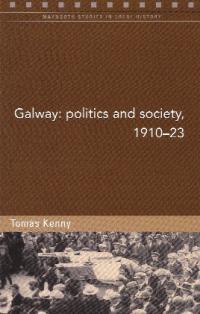Galway: politics and society, 1910–23
Published in 20th-century / Contemporary History, Issue 4 (July/August 2012), Reviews, Revolutionary Period 1912-23, Volume 20
Galway: politics and society, 1910–23
Tomás Kenny
(Four Courts Press, €10)
ISBN 9781846822933
In the historiography of the Irish revolution, the idea that is often conveyed is that the violence was confined to a few areas: Dublin at the epicentre, with periodic eruptions in Belfast and the province of Munster in almost constant turmoil. In recent years, however, books that attempt to balance the picture have started to appear. Marie Coleman’s County Longford in the Irish revolution, 1910–1923 is one such work. In a similar vein, Tomás Kenny has now made a case for a re-examination of Galway’s place in the Irish revolutionary story.Kenny’s book is a tale of opportunities missed in the west. In the early twentieth century Galway seemed ripe for rebellion, combining such incendiary ingredients as land agitation, poverty, hunger and high levels of violence. It was not starved of attention either: it was a very heavily policed and garrisoned area, and many leading figures of the time, including celebrated suffragette Christabel Pankhurst and 1916 leader Patrick Pearse, visited the city and county in the lead-up to the Easter Rebellion. The First World War also had a major impact, although the initially high enlistment rates dropped off sharply after 1915, and Kenny estimates that 755 Galway men lost their lives in the war.Kenny argues convincingly that a mixture of leadership failures, conditions on the ground and sheer bad luck meant that Galway’s revolutionary potential was never truly fulfilled. There was tension between the local IRB leader, Tom Kenny, and the Volunteers’ leader, Liam Mellows, during the attempted rising in 1916. Kenny was interested in harnessing local land-hunger, while Mellows was more interested in the national question, meaning that there was a lack of coordinated leadership among the Galway rebels in 1916. Once the War of Independence began in 1919, both leaders were missing from the picture: Kenny fled to Boston while Mellows was also absent, leaving behind a vacuum that, despite their enthusiasm for the cause, the Galway Volunteers never overcame. It is also significant that the condition of the people drained momentum away from any potential insurrection. Locals in many parts of Galway faced poverty and hardship in their daily lives, which left little room for ideological sentiment. Finally, events simply went against the rebels. Ambushes missed their targets, communications were extremely sketchy, and the famous German gunrunning ship the Aud, whose cargo of rifles was supposed to arm the Volunteers, was intercepted by the Royal Navy. Remarkably, of the 20,000 rifles that went to the bottom of the sea, around 3,000 had been earmarked for distribution to Galway’s poorly equipped Volunteers. This is not to say that nothing happened in Galway, however. The author uses an impressive array of local newspapers and testimonies from the Bureau of Military History to paint the portrait of a city and county that saw their fair share of violence between 1916 and 1923. Tuam was the first town in the country to be sacked in reprisal by the Black and Tans, and it was followed by further reprisal raids on Gort and Clifden. One of the most interesting anecdotes unearthed is that William Joyce—later better known to the world as Lord Haw-Haw—was identified by the IRA as being involved in the infamous kidnapping and murder of Fr Michael Griffin by British forces in Galway City in 1920. Joyce escaped the IRA, as the cease-fire of 1921 arrived in time to save his life, but he would eventually be hanged for treason by the British government after World War II. Many times, however, events in Galway were overshadowed by occurrences elsewhere. For instance, news of the torture and killing of the Loughnane brothers by Auxiliaries in November 1920 was lost in the furore that surrounded Bloody Sunday in Dublin. By contrast, Galway escaped much of the worst of the Civil War, probably because the population was sick of turmoil. Nevertheless, despite this, Galway paid a high price: of the 77 republicans executed by the Free State, eleven were Galway men and six of those were shot by firing squad in Tuam in 1923.Kenny also has an interesting take on the whole concept of a county-by-county view of the Irish revolution. Galway is traditionally seen as a ‘quiet’ county and is generally viewed as a whole. Instead, the author argues that Galway is too big and too varied a county to be assessed as one unit. Most of the action that did take place happened either in the city or in the east of the county. The west was simply too poor and too preoccupied with survival to participate in the rebellion, while the comparatively prosperous east had more resources to devote to insurrection. He also points out that the British divided the county into two administrative units, and the IRA into even more, so historians should take a closer look at the various and competing forces at work within the county before dismissing its contribution to the revolution.All in all, this is an interesting and refreshing insight into an under-researched part of Irish history. It is part of the excellent Maynooth Studies in Local History series and it is to be hoped that there is more to come in the future. HI
Bernard Kelly is a post-doctoral researcher at the University of Edinburgh and author of Returning home: Irish ex-servicemen after the Second World War (Merrion, 2012).
















